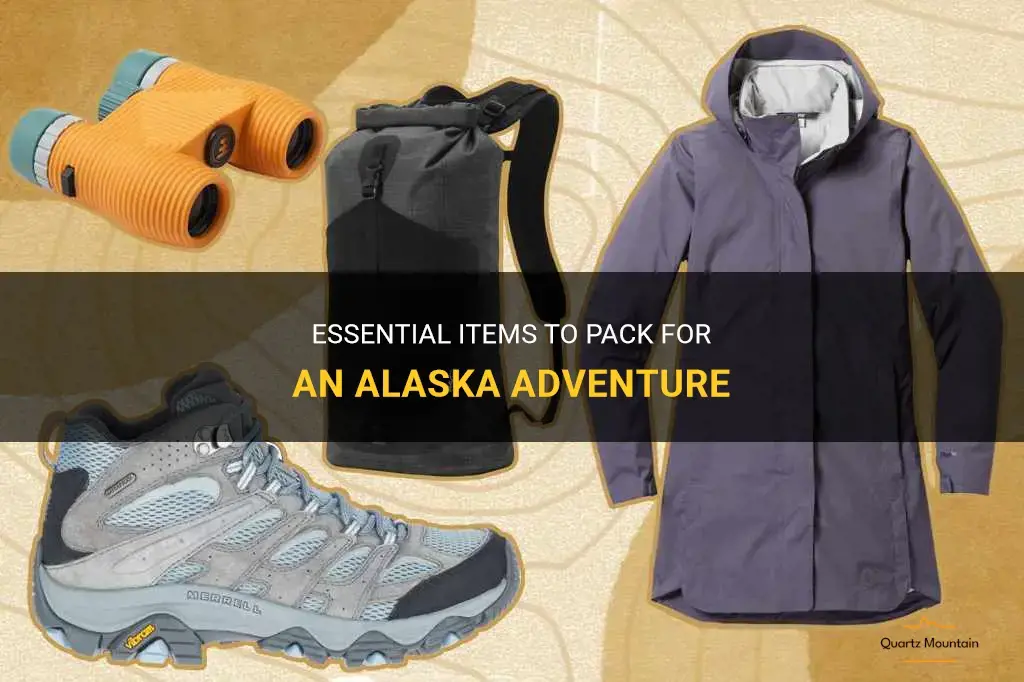
Planning a trip to Alaska? Get ready to embark on an unforgettable adventure in the last frontier. From breathtaking landscapes to incredible wildlife sightings, Alaska offers a unique experience for outdoor enthusiasts. But before you hit the road or hop on a plane, make sure you're packed with the essentials. In this guide, we'll take you through the must-have items for your Alaska adventure, ensuring that you're fully prepared for whatever this wild and untamed land has to offer. So, grab your packing list and let's get started on this exhilarating journey to the heart of Alaska.
| Characteristic | Value |
|---|---|
| Clothing | Layered clothing |
| Footwear | Waterproof boots |
| Accessories | Gloves, hat, scarf |
| Gear | Backpack, trekking poles |
| Sleeping gear | Sleeping bag, sleeping pad |
| Cooking gear | Stove, cookware, utensils |
| Food | High-energy, non-perishable items |
| Water | Water bottle, water filter |
| Navigation | Map, compass, GPS |
| Safety gear | First aid kit, bear spray |
What You'll Learn
- What clothing should I pack for an Alaska adventure?
- What type of footwear is appropriate for hiking in Alaska?
- Are there any specific items I should include in my first aid kit for an Alaska adventure?
- What kind of gear and equipment should I bring for outdoor activities in Alaska?
- Are there any special considerations for packing food and water for an Alaska adventure?

What clothing should I pack for an Alaska adventure?
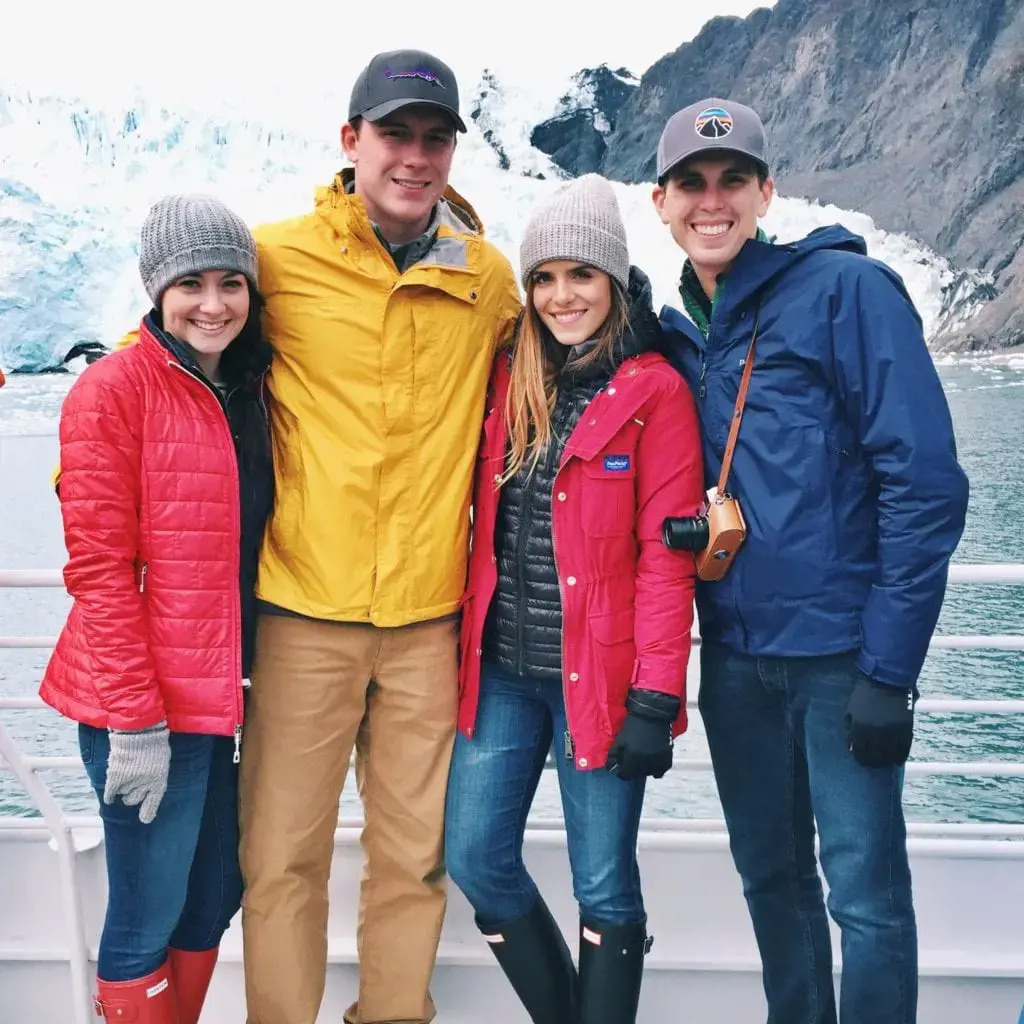
When planning an adventure in Alaska, it is important to pack the right clothing to ensure your comfort and safety in the unpredictable weather conditions. The key to packing for an Alaska adventure is to layer your clothing, as this will allow you to adjust to the changing temperatures throughout the day.
Here is a step-by-step guide to help you pack the right clothing for your Alaska adventure:
- Base Layer: Start with a good base layer, which is essential for regulating your body temperature. Look for moisture-wicking materials like merino wool or synthetic fabrics that will keep you dry and comfortable.
- Mid Layer: The mid layer provides insulation and should be warm yet lightweight. Fleece jackets or down vests are great options for this layer, as they trap heat and provide extra warmth when needed.
- Outer Layer: Choose a waterproof and windproof jacket as your outer layer. This will protect you from rain, snow, and strong winds. Look for jackets with a high level of breathability to allow sweat to escape and prevent overheating.
- Pants: Pack a combination of lightweight hiking pants and waterproof rain pants. The hiking pants will be comfortable for most activities, while the rain pants will protect you during wet weather conditions.
- Base Layers for Legs: Just like the upper body, it is important to layer your lower body as well. Pack moisture-wicking long underwear or leggings to wear under your pants for added warmth.
- Accessories: Don't forget to pack accessories that will keep you warm in cold temperatures. Include a warm hat, gloves, and a neck gaiter or scarf to protect your face from the wind.
- Footwear: Invest in a pair of sturdy, waterproof boots for your Alaska adventure. Look for boots with good traction to handle slippery terrains. Additionally, pack a few pairs of wool or synthetic socks to keep your feet warm and dry.
- Layering Tips: Remember to adjust your layers as needed. If you start to feel too warm, remove a layer to prevent sweating. On the other hand, if you feel cold, add an extra layer for insulation.
Here are some examples of clothing items you can pack for an Alaska adventure:
- Base Layer: Merino wool long-sleeve shirt and leggings.
- Mid Layer: Fleece jacket or down vest.
- Outer Layer: Waterproof and windproof jacket.
- Pants: Hiking pants and waterproof rain pants.
- Base Layers for Legs: Moisture-wicking long underwear.
- Accessories: Warm hat, gloves, and neck gaiter or scarf.
- Footwear: Sturdy, waterproof boots with good traction.
- Socks: Wool or synthetic socks.
By following these steps and packing the right clothing, you will be prepared to take on any weather conditions during your Alaska adventure. Remember to prioritize comfort and layering to ensure a comfortable and enjoyable experience.
Pine Cove Towers: The Essential Packing List for a Memorable Stay amidst Nature's Beauty
You may want to see also

What type of footwear is appropriate for hiking in Alaska?
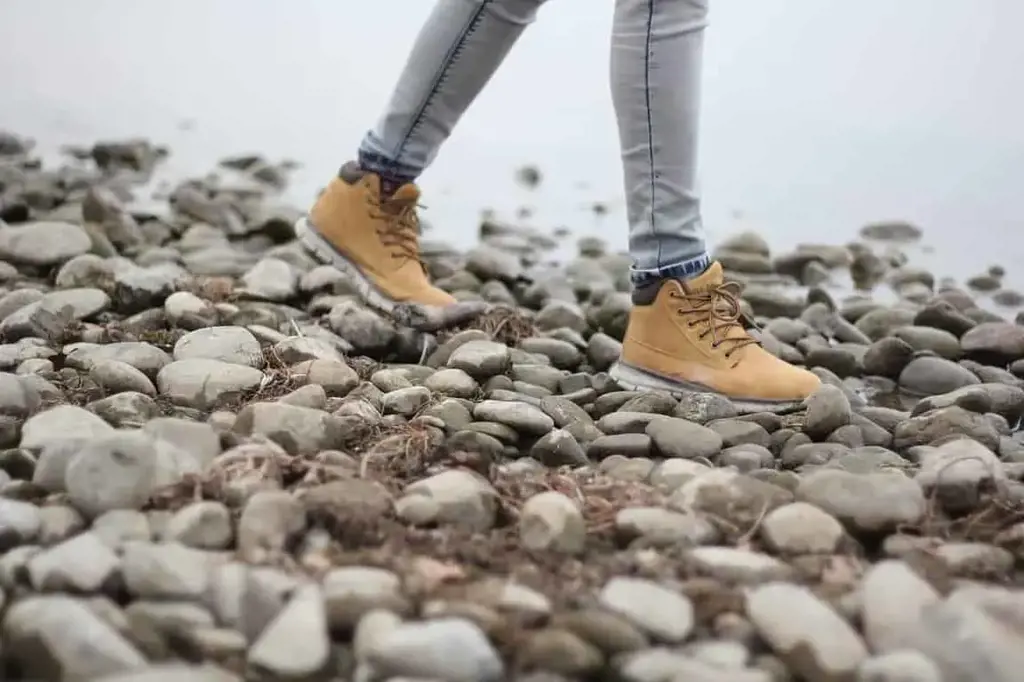
When planning a hiking trip in Alaska, it is crucial to choose the right footwear. Alaska's rugged and diverse terrain requires footwear that is comfortable, supportive, and durable. Hiking in Alaska can involve walking on rocky trails, crossing streams, and encountering uneven surfaces, so having the appropriate footwear is essential for a safe and enjoyable experience.
The first thing to consider when selecting hiking footwear for Alaska is the type of trail you will be hiking. If you will be exploring flat and well-maintained trails, a sturdy pair of hiking shoes might be sufficient. However, if your adventure will take you through more challenging and uneven terrain, hiking boots would provide better ankle support and protection.
In terms of material, consider investing in footwear made from waterproof and breathable fabrics. Alaska is known for its wet weather, and having waterproof footwear will keep your feet dry and comfortable. It is also important to choose a breathable material to prevent your feet from becoming sweaty and uncomfortable.
Additionally, make sure that the shoes or boots you choose have a good tread pattern for maximum traction. Alaska's trails can be muddy, rocky, or covered in loose gravel, so having a sole with a deep and gripping tread will help prevent slipping and provide stability.
When it comes to fit, your hiking footwear should provide ample support for your feet. The shoes or boots should have enough room to wiggle your toes but not be too loose, as this can lead to blisters and discomfort. It is also a good idea to wear thick hiking socks to help cushion your feet and prevent blisters.
Lastly, breaking in your hiking footwear before your trip is essential. Wearing them around the house or on short walks will help mold the shoes to your feet and soften any potential areas of friction. Wearing new footwear on a long hike can lead to painful blisters and sore feet.
Here are some excellent examples of hiking footwear that would be appropriate for hiking in Alaska:
- Hiking Shoes: Merrell Moab 2 Ventilator - These shoes provide breathability and support while still being lightweight for long hikes.
- Hiking Boots: Vasque St. Elias GTX - These boots offer excellent ankle support and waterproof protection, making them ideal for more rugged trails in Alaska.
- Trail Running Shoes: Salomon Speedcross 5 - These shoes are designed for off-road running and provide good traction and stability, making them suitable for fast-paced hikes on less challenging terrain.
In conclusion, when planning to hike in Alaska, it is essential to choose appropriate footwear that provides comfort, support, and durability. Consider the type of trail you will be hiking, the material and tread pattern of the footwear, proper fit and support, and breaking in the shoes or boots before your trip. By following these guidelines and investing in suitable hiking footwear, you can ensure a safe and enjoyable hiking experience in the beautiful Alaskan wilderness.
Choosing the Right Size Pack for Thru-Hiking the Appalachian Trail
You may want to see also

Are there any specific items I should include in my first aid kit for an Alaska adventure?
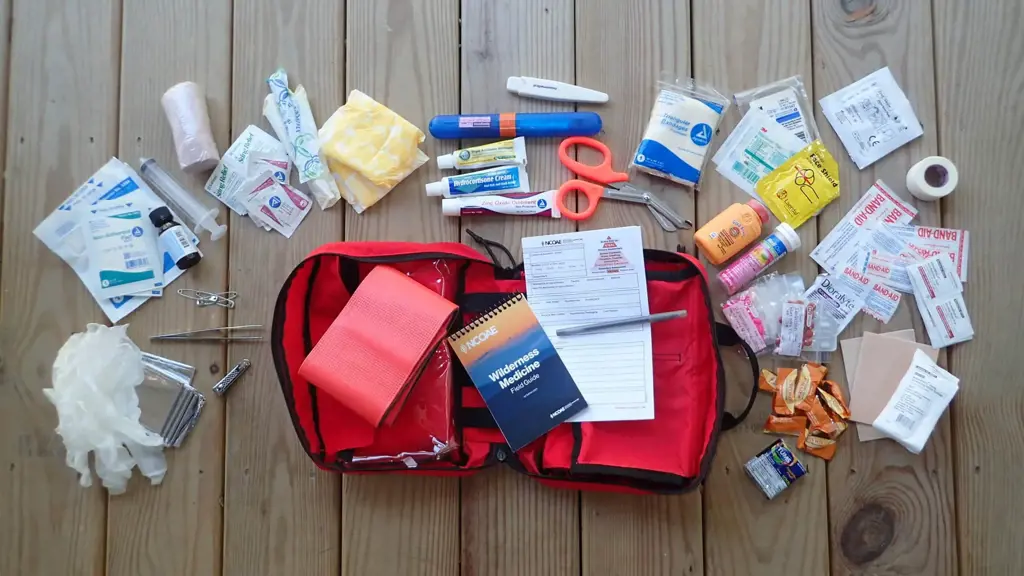
When embarking on an adventure in Alaska, it is crucial to be prepared for any potential injuries or emergencies that may arise. One essential item to have is a well-equipped first aid kit. While the contents of a first aid kit may vary depending on personal preferences and the specific activities planned, there are a few key items that should be included for an Alaska adventure.
- Bandages and dressings: Include a variety of adhesive bandages in different sizes, as well as sterile gauze pads and adhesive tape. These can be used to dress minor wounds, cuts, or blisters.
- Antiseptic wipes and ointments: Pack antiseptic wipes to clean wounds and prevent infection. Additionally, include antibiotic ointment to apply to cuts and scrapes.
- Pain relief medications: Acetaminophen or ibuprofen can help alleviate pain from minor injuries or headaches. Consider including a small bottle of electrolyte-replenishing tablets to combat dehydration and muscle cramps.
- Tweezers and scissors: These tools can come in handy for removing splinters, ticks, or small foreign objects from wounds. Remember to pack blunt-tipped scissors to avoid accidentally injuring yourself.
- A splint or brace: For more severe injuries, it is important to be prepared. Include a compact splint or brace that can immobilize a sprained or broken limb temporarily until medical help can be obtained.
- Cold and heat packs: Pack instant cold packs to reduce swelling and apply heat packs for muscle or joint pain. These can be especially important in the cold Alaskan climate.
- Emergency blanket: In case of exposure to extreme cold, an emergency blanket can help retain body heat and prevent hypothermia.
- Moleskin: Protect your feet from blisters by including moleskin. It provides cushioning and acts as a barrier between your skin and footwear.
- Hand sanitizer: Keeping hands clean is essential for preventing infections. Carry a small bottle of hand sanitizer to use when soap and water are unavailable.
- Personal medications: If you take prescription medications, be sure to pack an ample supply for the duration of your trip. Additionally, bring any necessary over-the-counter medications for personal conditions or allergies.
Remember, knowledge on basic first aid techniques is paramount when using a first aid kit. Familiarize yourself with the instructions and protocols for each item in your kit before your trip. It is also wise to have a comprehensive wilderness medical training or consult with a medical professional for specific first aid needs based on your activities and health conditions.
While a first aid kit is an important tool in addressing minor injuries, it is crucial to seek professional medical assistance for more severe or life-threatening situations. Be prepared, stay safe, and enjoy your Alaskan adventure!
The Essential Guide to Packing Food for Your Hotel Stay
You may want to see also

What kind of gear and equipment should I bring for outdoor activities in Alaska?
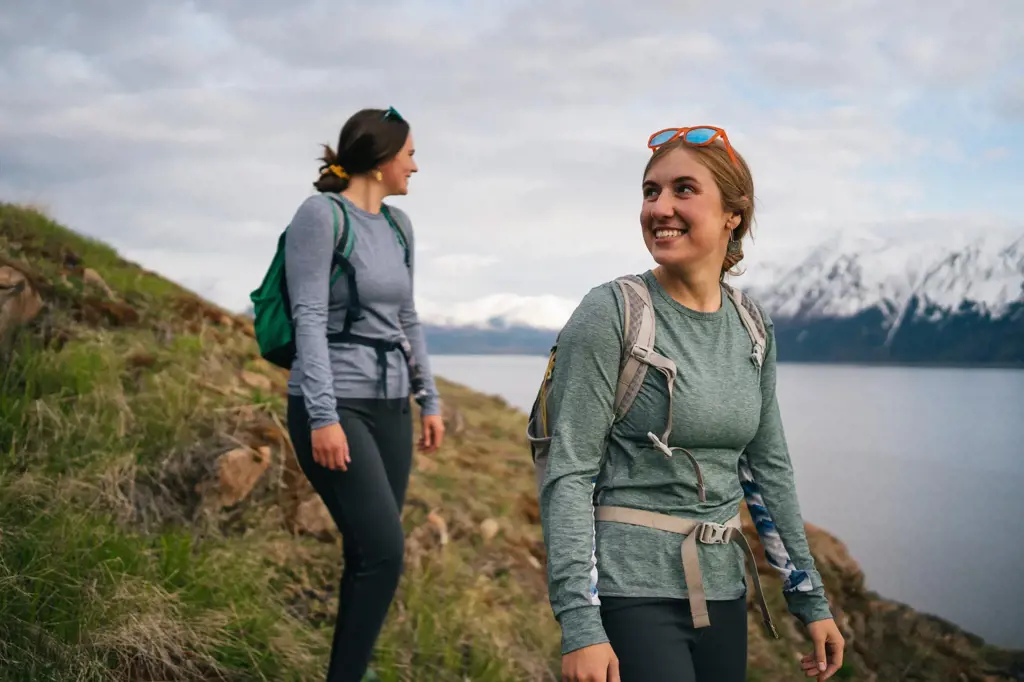
When planning outdoor activities in Alaska, it is important to be prepared with the right gear and equipment to ensure a safe and enjoyable experience. Alaska is known for its rugged terrain, unpredictable weather, and abundant wildlife, so being properly equipped is essential. Here is a list of gear and equipment to consider when heading out into the Alaskan wilderness.
- Clothing: Layering is crucial when dressing for Alaska's ever-changing climate. Start with a moisture-wicking base layer, such as merino wool or synthetic materials, to keep you dry. Add a warm insulating layer, such as a fleece or down jacket, and top it off with a waterproof and windproof outer layer. Don't forget to bring a good pair of waterproof boots, durable hiking pants, and gloves.
- Backpack: A sturdy backpack is essential for carrying all your gear comfortably. Look for one with a capacity of at least 40 liters to accommodate your clothing, food, water, and other essentials. Make sure it has excellent padding and adjustable straps for a proper fit.
- Navigation tools: Alaska's vast wilderness can be challenging to navigate, so always carry a map and a compass. Familiarize yourself with the area you will be exploring beforehand, and know how to use these tools properly. Additionally, consider bringing a GPS device or a topographic app on your smartphone as a backup.
- Tent and sleeping bag: If you plan on camping overnight, a high-quality tent and sleeping bag are crucial for a comfortable night's sleep. Look for a tent specifically designed for harsh weather conditions, with a sturdy frame and waterproof fly. Your sleeping bag should be rated for the temperatures you expect to encounter, and don't forget a sleeping pad for extra insulation and comfort.
- Cooking gear: Depending on the length of your trip, you may need cooking gear to prepare meals. A lightweight camping stove and fuel canisters are recommended, along with a pot, pan, and utensils. Always follow proper safety protocols when cooking in the wilderness to avoid wildlife encounters.
- Water filtration system: Alaska is known for its pristine rivers, but it's always a good idea to carry a water filtration system to ensure safe drinking water. You can choose from a variety of options, such as water filters, purifying tablets, or UV light sterilizers.
- First aid kit: Accidents can happen, so always carry a well-stocked first aid kit. Make sure it includes bandages, adhesive tape, antiseptic wipes, pain relievers, and any necessary prescription medications. Familiarize yourself with basic wilderness first aid techniques before your trip.
- Bear safety gear: Alaska is home to a large population of bears, so it's essential to be prepared for potential encounters. Carry bear spray, which is an effective deterrent against bear attacks. Additionally, consider bringing bear-resistant food canisters to store your food and avoid attracting bears to your camp.
Remember that this is not an exhaustive list, and your gear requirements may vary depending on the specific activity you plan to engage in. It's always a good idea to consult local experts or experienced outdoor enthusiasts for guidance. Be sure to check the Alaska Department of Natural Resources website for any regulations or safety advisories before embarking on your adventure. With the right gear and equipment, you can have a safe and memorable outdoor experience in the beautiful Alaskan wilderness.
Essential Items to Pack for a Memorable Scout Summer Camp
You may want to see also

Are there any special considerations for packing food and water for an Alaska adventure?
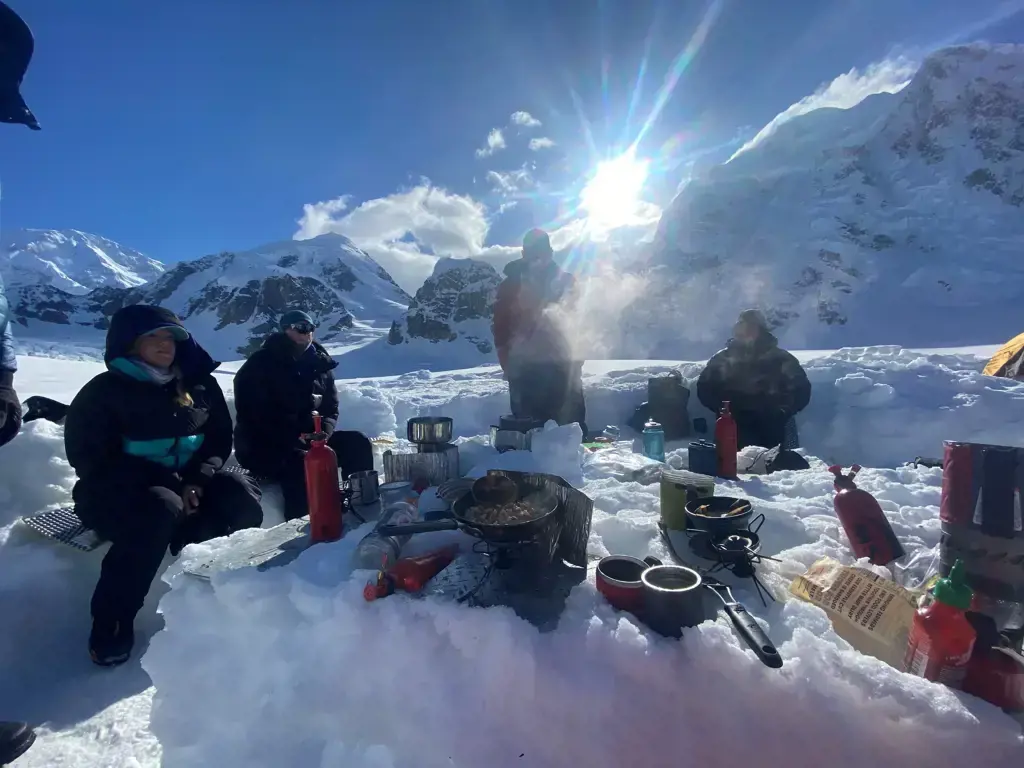
When embarking on an adventure in Alaska, it's important to be well-prepared, especially when it comes to food and water. The vast and often remote wilderness of Alaska presents unique challenges, and taking the time to plan and pack appropriately can ensure a safe and enjoyable trip. Here are some special considerations to keep in mind when packing food and water for an Alaska adventure:
- Caloric intake: Alaska's rugged terrain and cold weather conditions can increase the caloric needs of individuals engaging in outdoor activities. It is crucial to pack enough food to meet these increased energy requirements. High-calorie and nutrient-dense options like energy bars, nuts, dried fruits, and jerky can help sustain energy levels during long hikes or recreational activities.
- Meal planning: Planning meals in advance can help minimize packing space and ensure a balanced diet. Consider meals that are lightweight, easy to prepare, and provide a good mix of carbohydrates, proteins, and healthy fats. Dehydrated or freeze-dried meals are popular options among backpackers and outdoor enthusiasts due to their lightweight nature and long shelf life. These meals can be rehydrated with hot water and provide a hot and satisfying meal after a long day of exploring.
- Food preservation: Alaska's cool climate can help keep perishable foods fresh for longer periods. However, it's still important to take precautions to prevent spoilage. Keep perishable items, such as meats, dairy products, and fresh fruits and vegetables, in insulated coolers or waterproof containers to maintain their quality. Packing ice or freeze packs can help maintain lower temperatures and extend the life of these items.
- Water sources: Alaska is known for its abundant freshwater resources, including rivers, lakes, and streams. However, it is crucial to treat all water before consuming it to prevent gastrointestinal illnesses caused by harmful bacteria, viruses, and parasites. Boiling water for at least one minute is one of the most effective methods of water purification. Alternatively, using water filters or chemical water treatment tablets can also ensure safe drinking water.
- Hydration: Staying hydrated is essential, particularly in Alaska's colder climate, where the risk of dehydration can be deceptive. Remember to drink water regularly, even if you don't feel thirsty, to prevent dehydration. Consider using a hydration bladder or water bottles with insulating sleeves to help prevent water from freezing in colder temperatures.
- Environmental considerations: When packing food and water for an Alaska adventure, it's essential to be mindful of the environment. Avoid packing excessive single-use plastic bottles or packaging that can contribute to litter. Instead, opt for reusable water bottles and food containers to minimize waste. Dispose of any food waste properly by packing it out or following Leave No Trace principles.
In conclusion, packing food and water for an Alaska adventure requires careful planning and consideration. Focus on high-calorie foods, plan meals in advance, and take steps to preserve food. Treat all water sources before consumption and ensure proper hydration. Be mindful of the environment and pack responsibly. Following these guidelines will help ensure a safe and enjoyable experience in the Alaskan wilderness.
Essential Items for a Stress-Free AUC Trip: Your Packing Guide
You may want to see also
Frequently asked questions
When packing for an adventure in Alaska, it is important to be prepared for various weather conditions. Layered clothing is key, as the temperature can vary greatly throughout the day. Be sure to pack warm, insulated clothing such as a heavy jacket, hat, gloves, and thermal socks. Additionally, pack waterproof clothing and sturdy hiking boots to protect against rain, snow, and muddy terrain. Don't forget items like a headlamp, sunscreen, bug repellent, and a first aid kit.
Yes, it is important to be prepared for wildlife encounters when adventuring in Alaska. It is recommended to bring bear spray, which can be a useful deterrent if you encounter a bear. Also, make sure to carry a whistle or bear bells to make noise and alert animals of your presence. Binoculars can also come in handy for safely observing wildlife from a distance.
While you may want to unplug and enjoy the wilderness of Alaska, there are some electronics that can come in handy. A GPS device can be useful for navigation, especially if you plan on hiking or exploring off the beaten path. Additionally, a camera or smartphone with a good quality camera can help capture the stunning landscapes and wildlife you encounter. Just make sure to bring extra batteries or a portable charger, as you may not always have access to electricity.
If you plan on camping during your Alaska adventure, there are a few essential items to pack. A sturdy, waterproof tent is a must to protect you from the elements. Sleeping bags rated for cold temperatures and a camping mattress or sleeping pad for insulation and comfort are also important. Additionally, bring cooking equipment, such as a camping stove and cookware, as well as plenty of food and water. Consider packing bear-proof food containers and a bear-resistant cooler to prevent bears from accessing your food.







